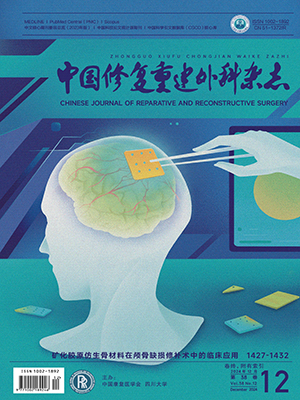To investigate the preventive effect of TGF-β1 neutral izing antibody on collagen production and adhesion formation of flexor tendon. Methods Tendon fibroblasts, epitenon tenocytes, and endotenon tenocytes were obtained from 6 New Zealand rabbit flexor tendons. Each cell culture was supplemented with 1 ng/mL of TGF-β along with increasing dose of TGF-β1 neutral izing antibody. Col I production was measured by enzyme-l inked immunoabsorbent assay after 3 days. Eighty-four adult New Zealand White rabbits forepaws underwent sharp transection of middle digit flexor digitorum
profundus and immediate repair. Then the rabbits were divided into three groups: the normal saline (NS group, n=36), 1.0 µg/ mL TGF-β1neutral izing antibody (1.0 µg/mL TGF-β1group, n=36) and 2.0 µg/mL TGF-β1 neutral izing antibody (2.0 µg/mL TGF-β1 group, n=12) were injected in tendon sheath respectively. Tendons were harvested at 4 and 8 weeks for biomechanics testing, histological evaluation and scanning electron microscope observation. Tendons were harvested at 1, 2, 4 and 8 weeks to determine the mRNA expression of TGF-β1 and Col I by in situ hybridization. Results ELISA exhibed that TGF-β1 enhanced Col I production and the neutral izing antibody significantly inhibited TGF-β1-induced Col I production in all 3 cell culture with a dose-dependent. At 4 and 8 weeks after operation the gl iding excursion of the tendon and the simulated active flexion in NS group were less than that of 1.0 µg/mL TGF-β1 group and 2.0 µ g/mL TGF-β1 group. There was significant difference between NS group and 1.0 µ g/mL TGF-β1 group, 2.0 µ g/mL TGF-β1 group (P lt; 0.05). The tendon anastomosis breaking strength showed no significant differences among three groups (P gt; 0.05). Scanning electron microscope and histological observation showed that collagen fibers arranged irregularly in NS group, but arranged regularly in 1.0 µ g/mL TGF-β1 group and 2.0 µ g/mL TGF-β1group at 4 and 8 weeks after operation. The in situ hybridization results revealed that TGF-β1 and Col I mRNA expression in 1.0 µ g/mL TGF-β1 group was lower than that in NS group at each time. There was significant difference between two groups (P lt; 0.05). Conclusion TGF-β1neutral izing antibody can inhibit the function of the TGF-β1 effectively and prevent adhesion formation after the flexor tendon injured and repaired.
Citation: XIA Changsuo,YANG Xuanying,HAN Yingqiu,SUN Kang,HONG Guangxiang. EFFECTS OF TGF-β1 NEUTRALIZING ANTIBODY ON COLLAGEN PRODUCTION AND ADHESION FORMATION OF FLEXOR TENDON. Chinese Journal of Reparative and Reconstructive Surgery, 2009, 23(6): 698-703. doi: Copy
Copyright © the editorial department of Chinese Journal of Reparative and Reconstructive Surgery of West China Medical Publisher. All rights reserved




